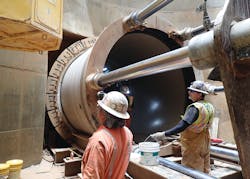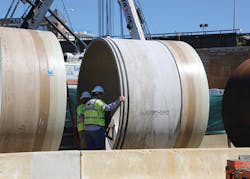The District of Columbia Water and Sewer Authority (DC Water) is implementing its Long Term Control Plan (LTCP) to meet requirements established by the U.S. Environmental Protection Agency for pollution control and reduction of combined sewer overflows (CSO) into nearby waterways.
The first segment of the LTCP, DC Clean Rivers Project Division H – Anacostia River Tunnel, is one of several contracts in the overall plan of deep tunnels, sewers and diversion facilities designed to capture overflows to Rock Creek as well as the Anacostia and Potomac rivers for treatment at the Blue Plains Advanced Wastewater Treatment Plant.
The Division H – Anacostia River Tunnel, which holds 100 million gallons of combined sewage and measures 23 feet in diameter, was commissioned in late March 2019. Together with the new 225 million-gallon-per-day wet weather treatment facility at Blue Plains, this 7-mile tunnel segment reduces combined sewer overflows by more than 80 percent.
Construction of the tunnel was launched in 2013 with the construction of six reinforced concrete slurry diaphragm wall shafts along the tunnel alignment. Next, microtunneling was used to insert the jacking pipes to connect the CSO-018 outfall to the tunnel system. Hobas Pipe USA supplied 320 feet of 120-inch, 1,765-ton jacking pipe for this project.
DC Water Resident Engineer Scott Shylanski said the Hobas pipe was jacked from DC Water’s CSO-018 shaft and was designed as the CSO-018 adit, approximately 300 linear feet long and 90 feet deep, to the Anacostia River Tunnel.
“The ends of the line — both at the shaft and tunnel connection — terminate near the structures and were embedded in a reinforced concrete collar,” he added.
The use of an intermediate jacking station allowed Seca Underground Corporation to isolate different parts of the pipe stream to overcome friction, said owner Steve Leius, whose company was subcontracted by main contractor Impreglio Healy Parsons JV to perform the microtunneling operation.
“The maximum tonnage applied at any time during the run was approximately 600 tons,” Leius said. “However, most of that — up to 400 tons plus — was required over time to overcome the face pressure because of the hydrostatic loads and the slurry pressure. It’s very interesting that at the end of the drive, the machine basically holed through using approximately 50 tons generated by skin friction.”
Due to the efficient nature of the installation, open trenches were not required and traffic disruption was kept to a minimum.
About two weeks after its opening, the tunnel passed its first real-life test when the District of Columbia sustained a rainfall of two inches within three hours. The tunnel stored and treated millions of gallons of combined sewage that would have previously flowed to the river. WW
Hobas Pipe is exhibiting at WEFTEC.19, booth 1021. To learn more, visit www.hobaspipe.com.





